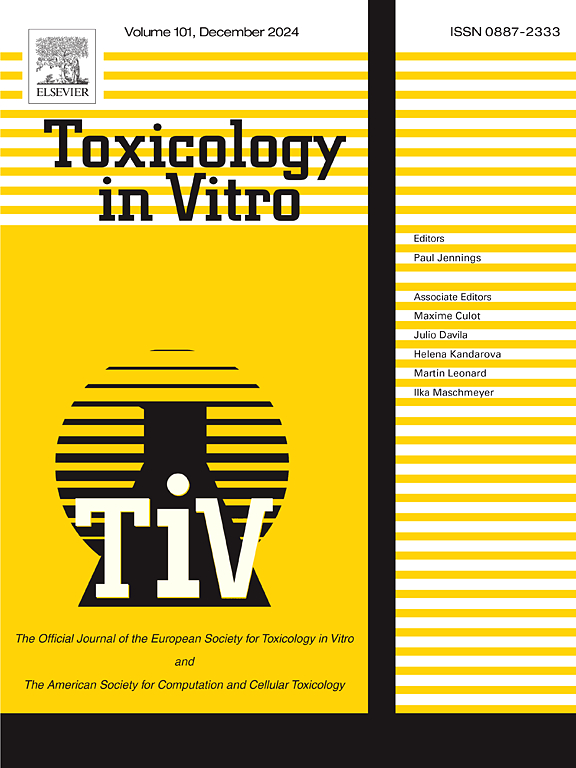Transcriptomic changes and mitochondrial toxicity in response to acute and repeat dose treatment with brequinar in human liver and kidney in vitro models
IF 2.6
3区 医学
Q3 TOXICOLOGY
引用次数: 0
Abstract
The potent dihydroorotate dehydrogenase (DHODH) inhibitor brequinar has been investigated as an anticancer, immunosuppressive, and antiviral pharmaceutical agent. However, its toxicity is still poorly understood. We investigated the cellular responses of primary human hepatocytes (PHH) and telomerase-immortalised human renal proximal tubular epithelial cells (RPTEC/TERT1) after a single 24-h exposure up to 100 μM brequinar. Additionally, RPTEC/TERT1 cells underwent repeated daily exposure for five consecutive days at 0.3, 3, and 20 μM. Transcriptomic analysis revealed that PHH were less sensitive to brequinar treatment than RPTEC/TERT1 cells. Upregulation of various phase I and II drug-metabolising enzymes, particularly Cytochrome P450 (CYP) 1 A and 3 A enzymes, in PHH suggests potential detoxification. Furthermore, brequinar exposure led to a significant upregulation of several stress response pathways in PHH and RPTEC/TERT1 cells, including the unfolded protein response, Nrf2, p53, and inflammatory responses. RPTEC/TERT1 cells exhibited greater sensitivity to brequinar at 0.3 μM with repeated exposure compared to a single exposure. Furthermore, brequinar could impair the mitochondrial respiration of RPTEC/TERT1 cells after 24 h. This study provides new insights into the differential responses of PHH and RPTEC/TERT1 cells in response to brequinar exposure and highlights the biological relevance of implementing repeated dosing regimens in in vitro studies.
体外模型人类肝脏和肾脏对布雷奎那急性和重复剂量治疗的转录组变化和线粒体毒性反应
有效的二氢羟酸脱氢酶(DHODH)抑制剂brequinar已被研究作为抗癌、免疫抑制和抗病毒药物。然而,人们对它的毒性仍然知之甚少。我们研究了初代人肝细胞(PHH)和端粒酶永生化的人肾近端小管上皮细胞(RPTEC/TERT1)在单次暴露于100 μM brequinar 24小时后的细胞反应。此外,RPTEC/TERT1细胞在0.3、3和20 μM下连续5天每天重复暴露。转录组学分析显示,PHH对brequinar处理的敏感性低于RPTEC/TERT1细胞。PHH中各种I期和II期药物代谢酶的上调,特别是细胞色素P450 (CYP) 1 A和3 A酶,提示潜在的解毒作用。此外,brequinar暴露导致PHH和RPTEC/TERT1细胞中几种应激反应途径的显著上调,包括未折叠蛋白反应、Nrf2、p53和炎症反应。与单次暴露相比,重复暴露于0.3 μM的RPTEC/TERT1细胞对brequinar的敏感性更高。此外,24 h后,brequinar可损害RPTEC/TERT1细胞的线粒体呼吸。这项研究为PHH和RPTEC/TERT1细胞对布雷奎那暴露的差异反应提供了新的见解,并强调了在体外研究中实施重复给药方案的生物学相关性。
本文章由计算机程序翻译,如有差异,请以英文原文为准。
求助全文
约1分钟内获得全文
求助全文
来源期刊

Toxicology in Vitro
医学-毒理学
CiteScore
6.50
自引率
3.10%
发文量
181
审稿时长
65 days
期刊介绍:
Toxicology in Vitro publishes original research papers and reviews on the application and use of in vitro systems for assessing or predicting the toxic effects of chemicals and elucidating their mechanisms of action. These in vitro techniques include utilizing cell or tissue cultures, isolated cells, tissue slices, subcellular fractions, transgenic cell cultures, and cells from transgenic organisms, as well as in silico modelling. The Journal will focus on investigations that involve the development and validation of new in vitro methods, e.g. for prediction of toxic effects based on traditional and in silico modelling; on the use of methods in high-throughput toxicology and pharmacology; elucidation of mechanisms of toxic action; the application of genomics, transcriptomics and proteomics in toxicology, as well as on comparative studies that characterise the relationship between in vitro and in vivo findings. The Journal strongly encourages the submission of manuscripts that focus on the development of in vitro methods, their practical applications and regulatory use (e.g. in the areas of food components cosmetics, pharmaceuticals, pesticides, and industrial chemicals). Toxicology in Vitro discourages papers that record reporting on toxicological effects from materials, such as plant extracts or herbal medicines, that have not been chemically characterized.
 求助内容:
求助内容: 应助结果提醒方式:
应助结果提醒方式:


